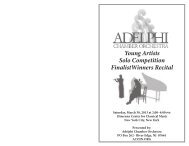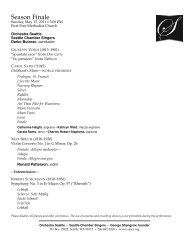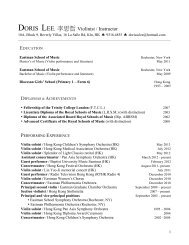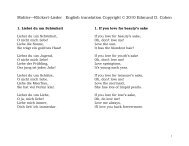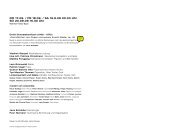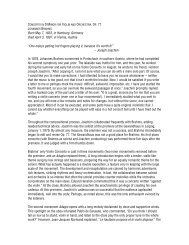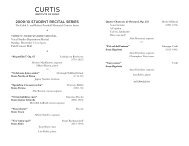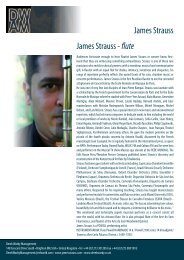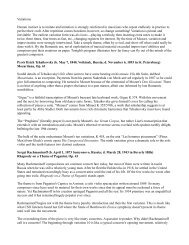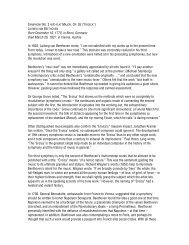The Curtis Institute of Music - InstantEncore
The Curtis Institute of Music - InstantEncore
The Curtis Institute of Music - InstantEncore
Create successful ePaper yourself
Turn your PDF publications into a flip-book with our unique Google optimized e-Paper software.
<strong>The</strong> <strong>Curtis</strong> <strong>Institute</strong> <strong>of</strong> <strong>Music</strong><br />
Roberto Díaz, President<br />
2007–08 Season<br />
<strong>The</strong> Beethoven Op. 95 Project<br />
A schoolwide study <strong>of</strong> Beethoven and his<br />
String Quartet No. 11 in F minor, Op. 95 (“Quartetto serioso”)<br />
Lecture and Demonstration<br />
A <strong>Music</strong>al Diagnosis: Tourette’s Syndrome and Beethoven’s<br />
Quartet No. 11 in F minor, Op. 95<br />
Tuesday, December 11 at 8 p.m.<br />
Field Concert Hall<br />
Twenty-Fourth Student Recital<br />
All-Beethoven Program<br />
Wednesday, December 12 at 8 p.m.<br />
Field Concert Hall<br />
Twenty-Sixth Student Recital<br />
Beethoven String Quartets<br />
Sunday, December 16 at 8 p.m.<br />
Field Concert Hall<br />
Next Semester<br />
<strong>The</strong> <strong>Curtis</strong> Symphony Orchestra conducted by<br />
Alan Gilbert in Mahler’s transcription <strong>of</strong> Op. 95<br />
Monday, February 11 at 8 p.m.<br />
Verizon Hall<br />
Tuesday, February 12 at 8 p.m.<br />
Carnegie Hall<br />
υ<br />
Quartet No. 11 in F minor, Op. 95 (“Quartetto serioso”)<br />
Allegro con brio<br />
Allegretto, ma non troppo<br />
Allegro assai vivace, ma serioso<br />
Larghetto espressivo—Allegretto agitato<br />
Sylvia Kim, violin<br />
Shanshan Yao, violin<br />
Philip Kramp, viola<br />
Abraham Feder, cello<br />
Photographic and recording equipment may not be used in Field Concert Hall.<br />
Recitals are pr<strong>of</strong>essionally recorded for educational use and possible broadcast.<br />
υ<br />
υ<br />
Performers<br />
Abraham Feder from Chicago is a student <strong>of</strong> David Soyer and Peter<br />
Wiley and entered <strong>Curtis</strong> in 2004.<br />
Sylvia Kim from Boca Raton, Fla., is a student <strong>of</strong> Pamela Frank and<br />
Ida Kavafian and entered <strong>Curtis</strong> in 2005.<br />
Philip Kramp from Bloomington, Ill., is a student <strong>of</strong> Joseph<br />
de Pasquale and Michael Tree and entered <strong>Curtis</strong> in 2005.<br />
Shanshan Yao from Anhui, China, is a student <strong>of</strong> Aaron Rosand<br />
and entered <strong>Curtis</strong> in 2003.<br />
If students study with more than one faculty member, their teachers are listed<br />
alphabetically.
<strong>The</strong> <strong>Curtis</strong> <strong>Institute</strong> <strong>of</strong> <strong>Music</strong><br />
Roberto Díaz, President<br />
A Quartet for 160<br />
Adapted from Overtones, Fall 2007<br />
One <strong>of</strong> <strong>Curtis</strong>’s special qualities has always been its intimacy. Social<br />
encounters are easy among our 160 students, who share a common<br />
focus on music and constantly cross paths. And yet the demands <strong>of</strong><br />
rehearsals, lessons, and classes can take them in diverse directions,<br />
each student following a highly tailored course <strong>of</strong> study. Meeting the<br />
demands immediate to one’s own instrument and repertoire can make<br />
it difficult to step back and approach the art form in a holistic way.<br />
As we approached the new school year, we wondered how we<br />
might unite the student body around a single musical endeavor,<br />
prompting new and meaningful conversations among our young<br />
instrumentalists, singers, composers, and conductors. What if we could<br />
take all our students on a common journey with relevance to all,<br />
culminating in performance?<br />
Of course there is no one work in which all our students could<br />
perform; we could accommodate a symphony orchestra and twenty-five<br />
singers—but the fifteen or so pianists, four organists, six composers,<br />
and four conductors might pose a problem <strong>of</strong> proportion, not to<br />
mention staging! Instead we posed the question more broadly. Might<br />
we study a work not just through performance, but also in the<br />
classroom? Might our <strong>Music</strong>al Studies and Liberal Arts courses<br />
approach the chosen score and related works through analysis and<br />
through their cultural context?<br />
Choosing a composer was surprisingly easy. Beethoven came<br />
immediately to mind: a creator <strong>of</strong> significance in all musical forms; a<br />
great thinker, whose eloquent letters and conversation books testified<br />
to his complex inner life; and a tireless worker, who left behind<br />
laborious musical sketches that provide enlightening clues to his<br />
creative process. Beethoven, <strong>of</strong> course. But what work?<br />
We settled—paradoxically, perhaps—on a string quartet.<br />
Beethoven’s quartets are a world in themselves, fruitful for chamber<br />
music study but also for analysis. And his forward-looking,<br />
experimental String Quartet, Op. 95 (“Quartetto serioso”), <strong>of</strong>fers<br />
special opportunities. Op. 95 inspired a transcription for large string<br />
orchestra by Gustav Mahler, born a century later into a very different<br />
age and interpretive tradition. Mahler saw symphonic scale in this<br />
quartet, and his homage transforms the piece.<br />
This core idea has taken shape as our Beethoven Op. 95 project.<br />
Each string chamber group has rehearsed Op. 95 this semester. This fall<br />
all <strong>of</strong> our string students are gaining an understanding <strong>of</strong> Op. 95 from<br />
the inside out—as chamber music. Next it will be time for a fresh look,<br />
as orchestra rehearsals begin for the February concert, which includes<br />
the Mahler transcription.<br />
Meanwhile, Op. 95 features as a subject for analysis in a <strong>Music</strong>al<br />
Studies course dedicated to Beethoven. Several Liberal Arts electives<br />
honed in on Beethoven’s letters. A guest lecture by the composer<br />
Bruce Adolphe will shed light on the questing mind behind this<br />
magnificent work.<br />
As our students probe deeply into one <strong>of</strong> the most expansive<br />
minds in music, they’ll have a platform for both formal classroom<br />
discussions and informal, lively dialogues <strong>of</strong> their own. <strong>The</strong>se will be a<br />
highlight <strong>of</strong> our fall and winter months. This week—leading up to the<br />
composer’s birthday, December 16—the circle widens as our friends<br />
and our student recital audiences hear student quartets playing Op. 95<br />
and other students performing music by Beethoven.<br />
<strong>The</strong>n, in February, larger audiences will join us in Verizon and<br />
Carnegie halls as the <strong>Curtis</strong> Symphony Orchestra performs the<br />
“Quartetto serioso” as re-imagined by Mahler, under the direction <strong>of</strong><br />
Alan Gilbert (’92). Those performances will contain the efforts not<br />
only <strong>of</strong> the string players we see on stage, but <strong>of</strong> all our students who<br />
have contributed to an animated and rich discussion.<br />
Roberto Díaz, President



